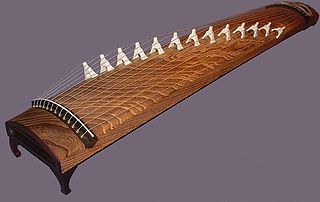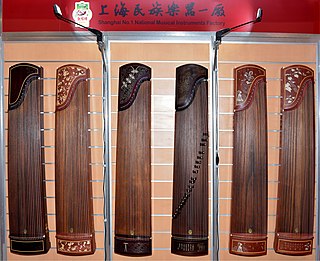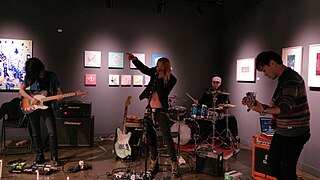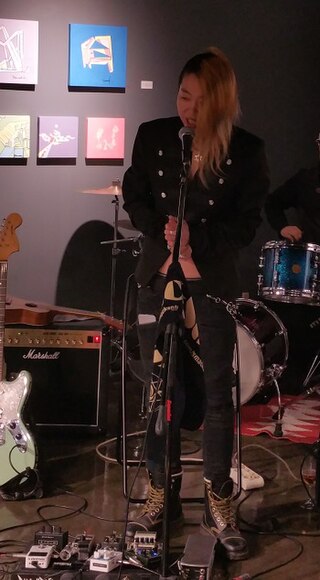
The koto is a Japanese plucked half-tube zither instrument, and the national instrument of Japan. It is derived from the Chinese zheng and se, and similar to the Mongolian yatga, the Korean gayageum and ajaeng, the Vietnamese đàn tranh, the Sundanese kacapi and the Kazakh jetigen. Koto are roughly 180 centimetres (71 in) in length, and made from Paulownia wood. The most common type uses 13 strings strung over movable bridges used for tuning, different pieces possibly requiring different tuning. Seventeen-string koto are also common, and act as bass in ensembles. Koto strings are generally plucked using three fingerpicks, worn on the first three fingers of the right hand.

The music of South Korea has evolved over the course of the decades since the end of the Korean War, and has its roots in the music of the Korean people, who have inhabited the Korean peninsula for over a millennium. Contemporary South Korean music can be divided into three different main categories: Traditional Korean folk music, popular music, or K-pop, and Western-influenced non-popular music.

The gayageum or kayagum is a traditional Korean musical instrument. It is a plucked zither with 12 strings, though some more recent variants have 18, 21 or 25 strings. It is probably the best known traditional Korean musical instrument. It is based on the Chinese guzheng and is similar to the Japanese koto, Mongolian yatga, Vietnamese đàn tranh, Sundanese kacapi and Kazakh jetigen.

The geomungo, alternate name hyeongeum, is a traditional Korean plucked zither with both bridges and frets. Geomungo is a representative stringed instrument made in Goguryeo before the 5th century. Scholars believe that the name refers to Goguryeo and translates to "Goguryeo zither" or that it refers to the colour and translates to "black crane zither".
Korean hip-hop, also known as K-hip-hop or K-rap, is a subgenre of the South Korean popular music.

The zheng or guzheng, is a Chinese plucked zither. The modern guzheng commonly has 21, 25, or 26 strings, is 64 inches long, and is tuned in a major pentatonic scale. It has a large, resonant soundboard made from Paulownia wood. Other components are often made from other woods for structural or decorative reasons. Guzheng players often wear a fingerpick made from materials such as plastic, resin, tortoiseshell, or ivory on one or both hands.

Lee Hyo-ri is a South Korean singer, record producer, activist, actress and television presenter. She debuted as a member of group Fin.K.L in 1998, which became one of the most popular girl groups in South Korea during the late 1990s and early 2000s. Aside from Fin.K.L, she has also participated in several project groups, including the Refund Sisters and SSAK3 in 2020.
Hwang Byungki was the foremost South Korean player of the gayageum, a 12-string zither with silk strings. He was also a composer and an authority on sanjo, a form of traditional Korean instrumental music.

Jin Hi Kim is a composer and performer of komungo and electric komungo, and a Korean music specialist.

The ajaeng is a Korean string instrument. It is a wide zither with strings of twisted silk. It is played with a slender stick of forsythia wood that is drawn across the strings in the manner of a bow. The ajaeng mainly plays the bass part in ensemble music. And the ajaeng is divided into two types. The ajaeng used in court music is called jeongak ajaeng, and the ajaeng used in folk music is called sanjo ajaeng. The original version of the instrument, and that used in court music, has seven strings; while the ajaeng used for sanjo and sinawi has eight. Some instruments have as many as nine to twelve strings.similar to the koto but bowed
Kim Soo-chul is a South Korean singer, musician, and composer. He began his career in the late 1970s as a rock singer and musician, later releasing "modernized" traditional Korean music, and composing numerous film scores.
Korean rock is rock music from South Korea. It has roots in American rock, which was imported to South Korea by U.S. soldiers fighting in the Korean War and stationing in U.S. military bases in South Korea after the war. Around the U.S. military bases, local musicians could have opportunities to learn American rock music and perform it on stage for U.S. soldiers. As a result, many Korean rock bands, called Vocal Bands or Group Sound, started their musical careers in the 1960s. Under the military administration in the 1970s, rock music and its subculture were classified as a depraved youth culture and restricted. After the Korean Fifth Republic, the censorship policies under the military government were abolished and rock music became a mainstream genre in South Korea until the end of the 1980s. Today, rock music is not the main genre in the music market in South Korea, but it still occupies a big portion of music consumption in the nation.

Nicole Yongju Jung, referred to as Nicole, is an American singer based in South Korea. She is a member of South Korean girl group Kara. Her solo debut mini album, First Romance, was released on November 19, 2014.

Choi Seo-ah, better known by her stage name Juniel (주니엘) is a South Korean singer-songwriter. She began her career in Japan in 2011 before debuting in South Korea in 2012. In addition to her output as a solo artist, Juniel has released music as a member of the duos Romantic J, and Poetic Narrator.
Han Terra is a South Korean–born inventor, composer and musician. She was a child prodigy and was performing by age 6 as a Korean kayageum player beginning her training at the age of 4. She has invented a 24 stringed musical instrument called TeRra incorporating artificial intelligence.

The Barberettes (Korean: 바버렛츠) is a South Korean retro, doo-wop female group that debuted in 2014 as a trio, and is based in Seoul. With their covers and original music, they reproduce the sound of the 50s-60s music, and are referred to as a time slip girl group who travel back to the times of barbershop music and harmonizing girl groups. The group is composed of Shinae An Wheeler (Korean: 안신애) and Seon Lee Kyeong (Korean: 이경선). In 2019 The Barberettes and Sweet Sorrow form a harmony collab group SBSB (Korean: 스바스바).

Blueming is the sixth extended play by South Korean band CNBLUE. It was released on April 4, 2016, under FNC Entertainment and distributed by LOEN Entertainment. The band began developing the record within the same time period as "Cinderella" from 2gether (2015). Writing and recording for the album commenced in midst of the 2015 CNBLUE Live "Come Together" concert tour. Upon its completion, the band's record label announced that the quartet would release a mini-album.
Danpyunsun and the Sailors is a four-piece group that was formed in 2013, with veteran folk musician Hoegidong Danpyunsun at the center. The members, whose resumes cover a diverse range of music from classical and jazz to folk pop and experimental rock, continue to push for a new pop sound with a mixture of both Eastern and Western influences.

Whang Bo-ryung = Smacksoft, commonly known as Smacksoft, is a South Korean post-punk and experimental rock band formed in 2000 by the lead singer-songwriter Whang Bo-ryung.

Whang Bo-ryung is a South Korean-American singer, songwriter and painter. She is the lead vocalist and founder of the band Smacksoft. She released her first solo album, Cat With Three Ears, in April 1998.














